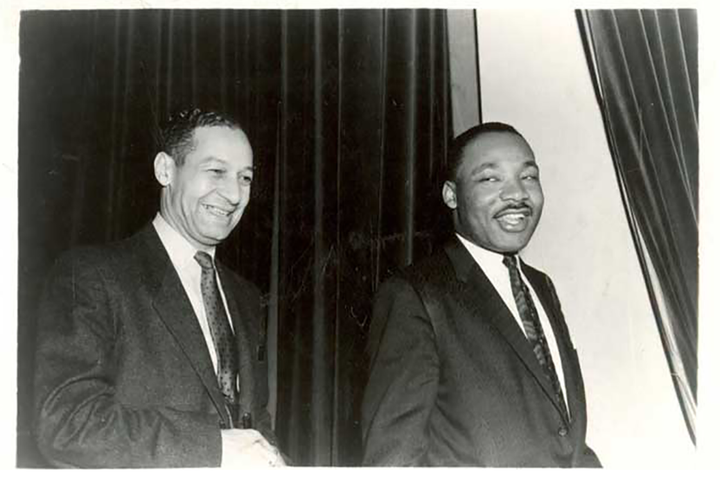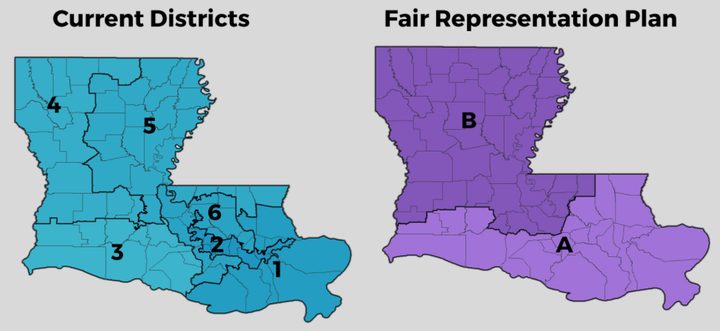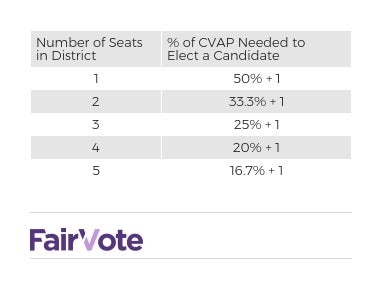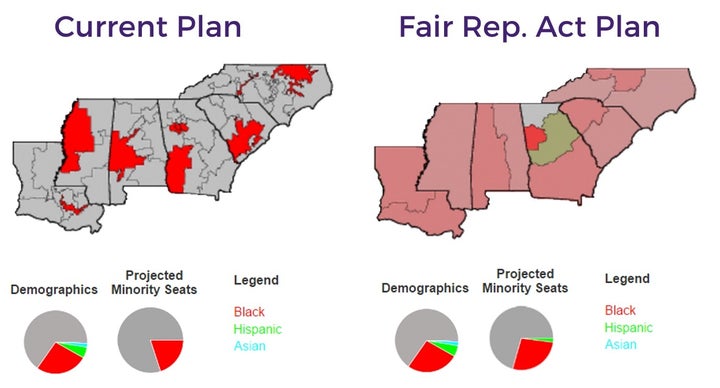
This post was written with FairVote Legal Director Drew Penrose, and Legal Fellow Dave O ’Brien.
The United States continues to fall short in fairly reflecting its diversity in elected offices. Our widespread use of a winner-take-all rule – that is, one where a slim majority of the vote will win 100% of representation – presents a challenge to candidates who are not the preferred choice of a majority of voters. This problem is particularly apparent in major statewide elections, as underscored by the fact that there are only 12 people of color serving among the 150 governors and U.S. Senators – two Republican governors who are Latino, one Democratic governor, who is Asian American and nine U.S. Senators.
The problem of under-representation is less acute in the U.S. House, where congressional districts are smaller and able to be drawn such that racial minorities become a majority. There are 94 people of color serving as voting members of the U.S. House, including 46 identifying primarily as African American, 34 as Latino, 12 as Asian American and 2 as Native American. But at 21% of seats, this remains far short of these groups’ total share of population as of the 2010 census (35%).
With the upcoming launch of the Fair Representation Act, legislation in Congress to change winner-take-all elections, in the coming week we will examine the state of representation of people of color in the current Congress and how it might change with enactment of the Fair Representation Act. We will start with a focus on African Americans in the South – the region of the country where most African Americans live.
The Current Landscape - A Series of Battles in Court
Although barely half-over, 2017 has already seen several high-profile court decisions on the interplay between gerrymandering and race. In May, the Supreme Court found that two North Carolina congressional districts were impermissibly drawn using race as a predominant factor, while in March it rejected a lower court’s finding that Virginia did not gerrymander its state legislative districts along racial lines. In March, a panel of federal judges found that three of Texas’s congressional districts were gerrymandered to dilute the influence of Latino voters.
America has a long and painful history of suppressing the political influence of racial minorities. Congress has periodically attempted to address the issue, notably through the Fourteenth, Fifteenth, and Twenty-Fourth Amendments and the Voting Rights Act of 1965, but as the steady flow of litigation demonstrates, the problem persists.
Litigation to resolve this issue has been an unending series of battles. Until 2013, the Voting Rights Act required jurisdictions with a history of discriminatory practices to get “preclearance” from the Justice Department before they could redraw voting districts. The Supreme Court effectively ended this requirement in Shelby County v. Holder, 570 U.S. 2 (2013), when it rejected the coverage formula used to determine which jurisdictions are subject to preclearance. Since then, districts gerrymandered to dilute the influence of racial minorities must be challenged after the fact, and on a case-by-case basis. A bill soon to be introduced in Congress offers an alternative.
The Fair Representation Act
The Fair Representation Act presents an innovative solution. It would change the way Americans elect members of the House of Representatives with a system proven at the local level and in other nations: ranked choice voting in multi-winner districts.
Ranked choice voting (or “RCV”) would change how voters select their representatives. For voters, the process is simple: rank the candidates in order of choice. Voters rank their favorite 1st, followed by their second-favorite, and so on. Studies show that voters like this approach to voting and handle it well.
Every vote cast counts for its top choice. If a candidate has more votes than the election threshold, they win, with any extra votes spilling over to help their next choices. If not all seats are filled, then the candidate with the fewest votes is eliminated, and votes cast for that candidate count for the next choice instead. This process repeats until all seats are filled. The election threshold is simply the number of votes that guarantees victory. In a 1-winner election, that is 50% + 1, a majority. In a multi-winner election, it is less. Under the Fair Representation Act, it will be between 17% and 25% in every state with at least three seats. That lower threshold is what allows minority voices to reliably earn their fair share of representation.
The second component of the FRA is the use of multi-winner districts. Under the current single-winner district system, each member of the House of Representatives represents a single district. After each census, the districts are redrawn to account for changes in population. In most states this is done by the legislature, allowing whichever party then in power to redraw the districts in ways that give it a built-in advantage in future elections. For those wishing to challenge these gerrymanders, the only recourse is a long and costly court challenge, which (if successful) will result in additional delays as new districts are drawn and a new election held.
Every state with more than one seat will elect representatives from multi-winner districts. States up to five seats will elect each member statewide. Larger states will be divided into districts that select between three and five representatives each. Under the FRA, this process will be done by independent commissions rather than partisan legislatures. The number of representatives each state sends to Congress wouldn’t change, but representatives would now jointly-represent shared districts. For example, Louisiana currently has six congressional districts, each sending a single member to the House of Representatives. The FRA would divide Louisiana into two larger districts, each sending three members to the House.

As with all of our simulated maps, this map is not intended to demonstrate what the final map will actually look like, but simply what multi-winner district maps can look like. This map was created by a computer program that sought to split as few counties (parishes in Louisiana) as possible and to otherwise create compact districts.
Impact on African American Representation in the South
Under this system, the percentage of a district’s citizen voting age population (“CVAP”) needed to elect a representative breaks down as follows:

Historically, when members of a racial minority community have exceeded this threshold, people representing that community do win election, even in at-large elections with severely racially polarized voting, provided the election uses ranked choice voting. For example, Cincinnati elected its first black city councilmember in an at-large election with ranked choice voting in 1931, when the city was only 10.6% African American. It elected nine representatives, and the threshold was 10%. Over 100 jurisdictions in states like Texas, Alabama, North Carolina, New York, and South Dakota have used other forms of fair representation voting and have seen the successful first elections of black, Latino, and Native American representatives in multi-winner districts.
In the new districts created using the Fair Representation Act, African American voters in Louisiana will have the power to elect a candidate with their own votes if they are over 25% of their district’s CVAP, even with total racially polarized voting. Right now, African Americans represent about a third of voters in Louisiana but only one of Louisiana’s six congressional districts is majority African American, and that is the only district with an African American representative (Cedric Richmond). About two-thirds of Louisiana’s African American population lives in the other 5, majority white (and solidly red) districts.
Under the Fair Representation Act, Louisiana’s two districts would each be about 30% African American. Because the threshold in these districts would be 25% + 1, black voters would have the power to elect a candidate of choice in both of them. Instead of only 32% of African Americans living in a district where they have the power to elect a candidate of choice, it would be 100%.
This trend would hold across the South. Looking at Louisiana, Mississippi, Georgia, South Carolina, and North Carolina, instead of 10 total majority-minority districts, there would be 14 seats where African American voters would have the power to elect a candidate of choice. Latino voters would exceed the threshold in one Georgia district, even though Latinos have never had a majority-minority district anywhere in this string of states. The percentage of African American voters living in a district where their CVAP crosses the threshold necessary to elect a representative would more than double, going from 40% to 98%.

African Americans living in these states would see an immediate and significant change in their congressional representation under the FRA. Although no one can predict outcomes with certainty, African American voters would have the power to elect more of their preferred candidates, and nearly every African American voter would be living in a district represented by at least one of their preferred candidates.
As mentioned earlier, there is historical precedent for the success of this kind of system in electing African American candidates. With strong black support, Frank A.B. Hall became the first African American elected to the Cincinnati city council in an at-large election held with RCV in 1931 even though the black population was barely 10 percent. ln 1949, Ted Berry, who would later become Cincinnati’s first black mayor, was also elected to the city council in an at-large election with RCV. With Berry positioned to become the first African American mayor of a major city, white voters in 1957 repealed RCV. At least one African American had served on council nearly continuously until repeal. The city then went six years before an African American was again elected to the city council. Berry remained a lifelong advocate of the system and was the opening speaker at FairVote’s founding conference in June 1992.
The Fair Representation Act would complement the Voting Rights Act and be a major step in guaranteeing that traditionally-underrepresented groups would have more influence in congressional elections. State legislatures would find it nearly impossible to dilute the votes of racial minority voters and courts would return to being the final safeguard of fair representation, rather than the primary one. It certainly won’t solve all the entrenched problems of our political system, but it’s an important step in empowering communities who have been traditionally shut out of the political process.
